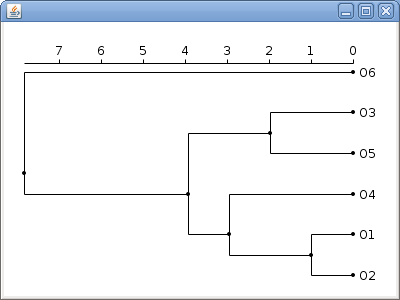Download
Step 1. Add the JitPack repository to your build file
Add it in your root settings.gradle at the end of repositories:
dependencyResolutionManagement {
repositoriesMode.set(RepositoriesMode.FAIL_ON_PROJECT_REPOS)
repositories {
mavenCentral()
maven { url 'https://jitpack.io' }
}
}Add it in your settings.gradle.kts at the end of repositories:
dependencyResolutionManagement {
repositoriesMode.set(RepositoriesMode.FAIL_ON_PROJECT_REPOS)
repositories {
mavenCentral()
maven { url = uri("https://jitpack.io") }
}
}Add to pom.xml
<repositories>
<repository>
<id>jitpack.io</id>
<url>https://jitpack.io</url>
</repository>
</repositories>Add it in your build.sbt at the end of resolvers:
resolvers += "jitpack" at "https://jitpack.io"
Add it in your project.clj at the end of repositories:
:repositories [["jitpack" "https://jitpack.io"]]
Step 2. Add the dependency
dependencies {
implementation 'com.github.lbehnke:hierarchical-clustering-java:1.2.0'
} dependencies {
implementation("com.github.lbehnke:hierarchical-clustering-java:1.2.0")
} <dependency>
<groupId>com.github.lbehnke</groupId>
<artifactId>hierarchical-clustering-java</artifactId>
<version>1.2.0</version>
</dependency>
libraryDependencies += "com.github.lbehnke" % "hierarchical-clustering-java" % "1.2.0"
:dependencies [[com.github.lbehnke/hierarchical-clustering-java "1.2.0"]]
Readme
hierarchical-clustering-java
Implementation of an agglomerative hierarchical clustering algorithm in Java. Different linkage approaches are supported:
- Single Linkage
- Complete Linkage
What you put in
Pass a distance matrix and a cluster name array along with a linkage strategy to the clustering algorithm:
String[] names = new String[] { "O1", "O2", "O3", "O4", "O5", "O6" };
double[][] distances = new double[][] {
{ 0, 1, 9, 7, 11, 14 },
{ 1, 0, 4, 3, 8, 10 },
{ 9, 4, 0, 9, 2, 8 },
{ 7, 3, 9, 0, 6, 13 },
{ 11, 8, 2, 6, 0, 10 },
{ 14, 10, 8, 13, 10, 0 }};
ClusteringAlgorithm alg = new DefaultClusteringAlgorithm();
Cluster cluster = alg.performClustering(distances, names,
new AverageLinkageStrategy());
Alternatively, you can pass a pdist-like matrix containing one row:
String[] names = new String[] { "O1", "O2", "O3", "O4", "O5", "O6" };
double[][] pdist = new double[][] {
{1, 9, 7, 11 ,14 ,4 ,3 ,8 ,10 ,9 ,2 ,8 ,6 ,13 ,10}
};
ClusteringAlgorithm alg = new PDistClusteringAlgorithm();
Cluster cluster = alg.performClustering(pdist, names, new MinimumLinkageStrategy());
What you get out
The algorithm creates a Cluster instance representing an hierachy of cluster nodes based on their distances. You may want to visualize the result using the Swing component DendrogramPanel:
DendrogramPanel dp = new DendrogramPanel();
dp.setModel(cluster);
When embedded into a JFrame the dendrogram panel should display this:

License
Licensed under the Apache License, Version 2.0 (the "License"); you may not use this file except in compliance with the License. You may obtain a copy of the License at (http://www.apache.org/licenses/LICENSE-2.0). Unless required by applicable law or agreed to in writing, software distributed under the License is distributed on an "AS IS" BASIS, WITHOUT WARRANTIES OR CONDITIONS OF ANY KIND, either express or implied. See the License for the specific language governing permissions and limitations under the License.